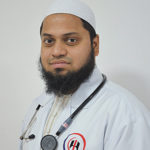If the hearing loss goes unnoticed, many do not develop normal speech, as the sense of hearing and speech are invariably linked.
By Dr. Saud Ahmed
The power of hearing is a great blessing bestowed upon us by Allah. It’s true value can be felt when we meet people who are hearing-impaired. It is indeed very sad to see children with this problem. If the hearing loss goes unnoticed, many do not develop normal speech as the sense of hearing and speech are invariably linked.
The ear mainly has two functions, one of hearing, and the other of balance. There are two nerves which rise from the ear, namely the vestibular and the cochlear nerves. These two nerves merge to form the vestibulocochlear nerve, which connects the ear to the hearing centre (Auditory Cortex) in the brain. So, any condition affecting the ear can cause either hearing deficits or balance disorders, commonly referred to as vertigo.
The ear can be divided into the external ear, middle ear and the inner ear. The external ear comprises of the pinna, the external auditory canal and the tympanic membrane (ear drum). The middle ear consists of an air-filled space behind the tympanic membrane and consists of small bones called ossicles”three in number. The inner ear consists of a snail-shaped structure called the cochlea, which contains tiny cells called hair cells, which are the main cells responsible for receiving sound. The labyrinth is another structure of the inner ear which plays a role in balancing of the body. The cochlea and the labyrinth are connected to the brain through the vestibulocochlear nerve.
The pathway for sound waves to reach the brain is as follows
1. External Auditory Canal -> 2. Tympanic Membrane (ear drum) -> 3. Middle ear -> 4. Ossicles -> 5. Cochlea -> 6. VestibuloCochlear Nerve -> 7. Hearing Centre in the brain (Auditory Cortex)
Common Causes of Hearing Loss at Various Levels :
External Auditory Canal – Impacted Ear Wax, Swelling of the canal due to infection
Tympanic Membrane – Perforation in the ear drum
Middle ear – Fluid in the middle ear
Ossicles – Stiffening/Discontinuity of ossicles
Cochlea – Abnormal fluid collection in the cochlea, damage to hair cells, congenital hearing loss, age related hearing loss
Vestibuloochlear Nerve – Tumours of the nerve, trauma to the nerve
Auditory Cortex – Central Nervous System Disorders
Treatment of hearing-loss depends on the cause of the same. In many cases it can be treated by simple procedures like wax removal. Some cases may require a surgical correction of hearing, like repairing a perforated drum or fixing the ossicles. A wide range of hearing aids are available for those with a sensorineural deafness or in those in whom surgery is not possible or has limited benefit.
Children with congenital hearing loss are diagnosed by newborn hearing screening. They can be offered a cochlear implant surgery as early as 1 year of age, where an electrode is surgically implanted into the Cochlea, which stimulates the hair cells directly.
On 3rd March, free consultation is being provided for hearing problems along with a fully computerised hearing evaluation between 10 am and 2 pm. Concessions are also being offered on Hearing Aid Devices till the 10th of March. Contact Primecare Hospital, No.158 MM Road (Near Bangalore East Railway Station), Frazer Town, Bangalore. Ph: 080 47004700.
(Dr. Saud Ahmed is an Ear, Nose, Throat Surgeon (ENT) and heads the Department of ENT, Head and Neck Surgery at Primecare. Email : [email protected])


COMMENTS